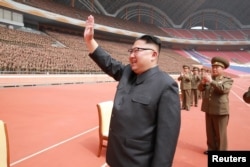A South Korean report using advanced technology to pinpoint scenes of North Korean atrocities marks a crucial step forward in documenting human rights abuses and setting the stage for future prosecutions.
The Transitional Justice Working Group's preliminary report released earlier this week identifies more than 300 execution sites and 47 burial grounds in North Korea.
Using Google Earth satellite imagery and testimony from 375 North Korean defectors, the Seoul-based human rights group focused on documenting the North's atrocities as "a crucial first step in pursuit of accountability for human rights crimes" committed in the country for decades under the Kim family regime, which was established in 1948. The group says it decided to not disclose the exact locations of sensitive sites lest the North Korean regime tamper with evidence.
"Sites of mass killings and mass burials tend to leave traces and … evidence that is scientific and tangible," said Lee Younghwan, who heads the Transitional Justice Working Group. "Through this report, I hope people who are committing atrocities realize that all of their actions are being monitored and recorded in detail and that someday they will face consequences for their misdemeanor."
Report draws praise
Greg Scarlatoiu, executive director of the Committee for Human Rights in North Korea, hailed the group's efforts in documenting the sites and collecting evidence.
"For a very long time, we've been aware of the brutality taking place, in particular, at detention facilities in North Korea, political prison camps, labor camps and other facilities. So this surely comes as no surprise," Scarlatoiu told VOA's Korean Service. "But being able to thoroughly research and document these violations, it's an entirely different story."
In 2014, the U.N. Commission of Inquiry (COI) issued a report documenting North Korea's systematic human rights abuses committed against its population. The COI found extrajudicial killings, enforced disappearances, arbitrary arrests, beatings, forced starvation, sexual assault, forced labor and torture to be pervasive. Many of them, the report noted, are committed in the North's political prison camps, where an estimated 80,000 to 120,000 men, women and children are incarcerated.
Some facilities have been shut down
When documenting the sites, Scarlatoiu suggested it is important to continue monitoring developments under the Kim Jong Un regime, saying "the North Korean political prison camps system has been in flux since it was established in 1950s."
For example, facilities close to the border with China have been shut down, detention facilities inland have been expanded and other new detention facilities have appeared, Scarlatoiu said.
"We have to continue to focus on collecting evidence both through direct contact with witnesses — with former prisoners and those who used to run camps and have defected — and through the use of technology — satellite imagery in particular," Scarlatoiu said. "This is a very powerful combination and I firmly believe that it is technological developments that will ultimately shatter the firewall surrounding the North Korean regime."










